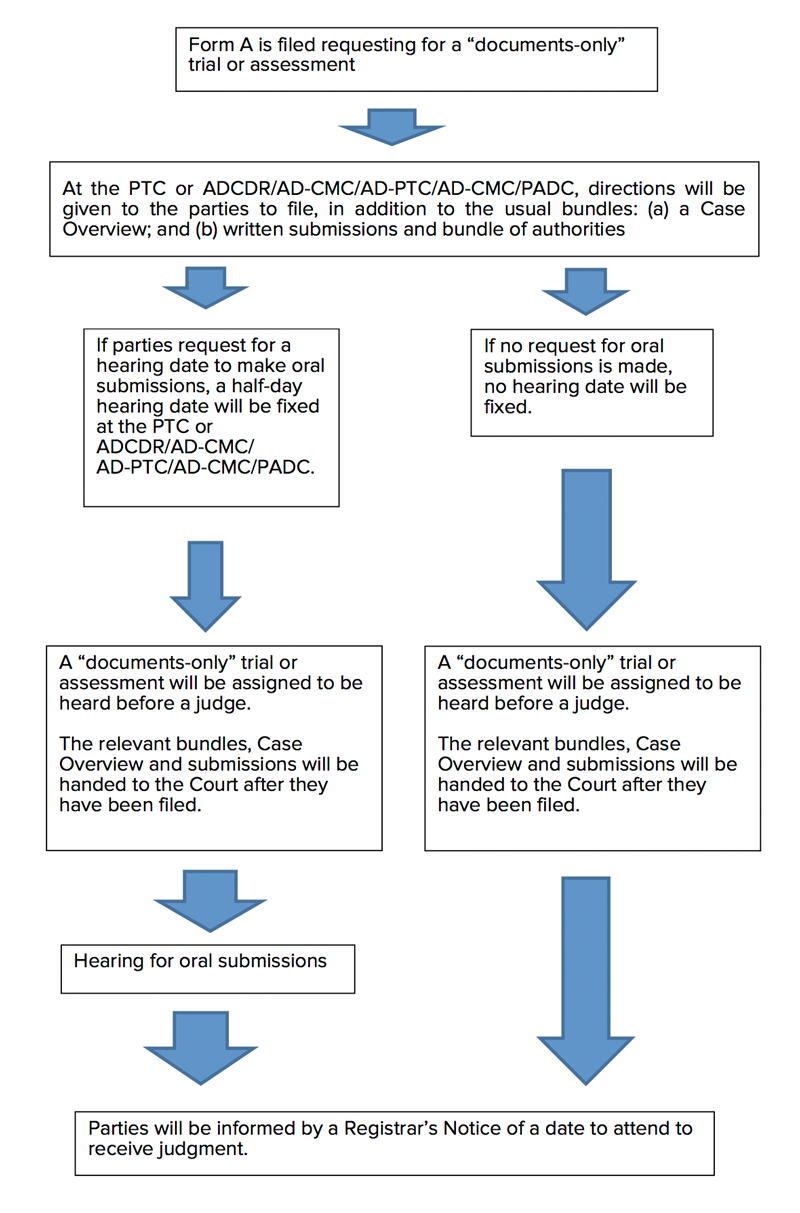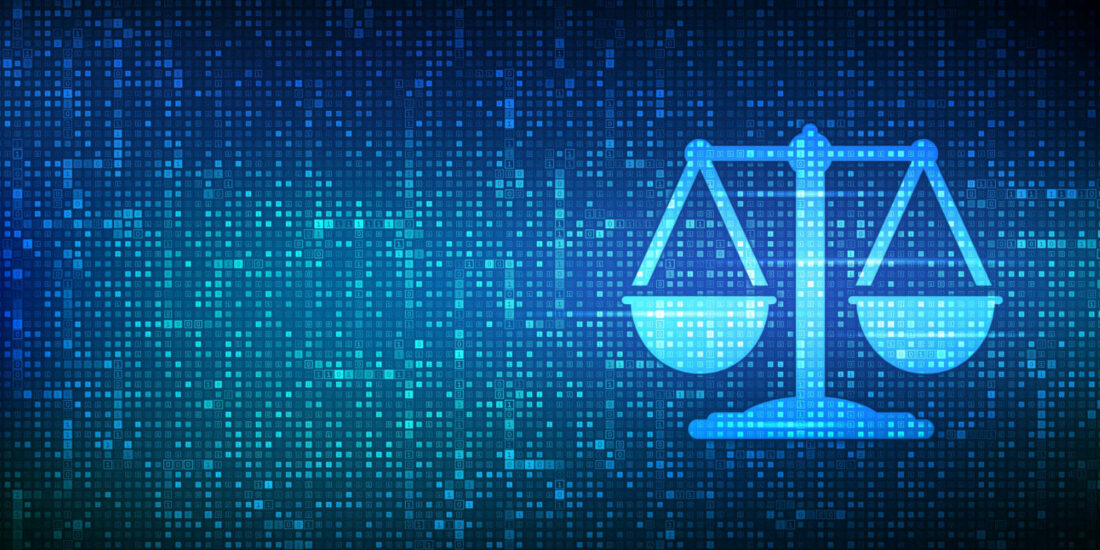
“Documents-Only” Civil Trials and Assessments of Damages in the State Courts of Singapore
A New and Cost-Efficient Mode of Determining Disputes in Court
Introduction
On 11 December 2017,1 See State Courts Registrar’s Circular No 4 of 2017 dated 13 November 2017. the State Courts of Singapore announced a pilot programme introducing a fresh and novel option for litigants – the conduct of civil trials and assessments of damages via a “documents-only” process.
Under this pilot programme, parties can mutually consent to and file a request seeking leave of the Court to:2 See request form marked as “Annex A” to State Courts Registrar’s Circular No 4 of 2017 dated 13 November 2017. (a) dispense with the attendance of witnesses at the civil trial or assessment of damages; (b) dispense with the attendance of counsel at a civil trial and assessment of damages; and/or (c) order that the dispute between parties be solely determined on the basis of affidavits of evidence-in-chief (AEICs), bundles of documents, bundles of pleadings and/or submissions tendered.
“Documents-only” dispute resolution proceedings have primarily existed as creatures of arbitration available to parties in Singapore and other international jurisdictions who have consented to their disputes being managed by arbitral rules which allow for “documents-only” proceedings and/or consented to their arbitrations being specifically resolved via a “documents-only” process.3 See, eg, Documents-Only Arbitration Procedures, Chartered Institute of Arbitrators (London, 2015); Law Society Arbitration Scheme Handbook, Law Society of Singapore (Singapore, 2017) at Part 2; The SIAC Expedited Procedure, Singapore International Arbitration Centre (2016) available at <http://www.siac.org.sg/2013-09-18-01-57-20/2013-09-22-00-31-29/archive-2012/240-the-siac-expedited-procedure> (accessed 9 February 2018).
Taking a leaf from this development in arbitral forums, the State Courts of Singapore have commenced a pilot programme for the conduct of civil trials and assessment of damages on a “documents-only” basis, with an aim towards: (a) creating an alternative and additional mode of conducting dispute resolution in the Singapore Courts; (b) meeting the needs of parties in a dispute who have to date had to resort to arbitration for the conduct of proceedings on a “documents-only” basis; and (c) saving costs and court fees for parties involved in inter alia low value disputes.
Why Should Parties Opt for A Documents-Only Trial or Assessment?
Traditionally at civil trials and assessments of damages, parties start with the submission of opening statements, followed by the presentation of evidence through the calling of witness(es); and end the hearing with closing submissions being tendered orally or in writing.
This process serves the purposes of natural justice and provided a framework where parties are able to present their full and complete case before the Court.
However, for certain types of cases, an alternative mode of trial or assessment may be preferable and more cost-efficient for litigants. This pilot programme allows parties to agree to and seek leave for the conduct of a “documents-only” trial or assessment of damages where:
- the issues in dispute centre on the interpretation of documents;
- the cross-examination of witnesses is not necessary either because there are no disputes of fact, and/or the parties agree to admit AEICs without the attendance of the witnesses (eg, due to the simplicity of issues in dispute, the small value of the claim, or any other valid reason);
- the Court may determine the dispute based on the existing contemporaneous documents without the testimony of witnesses;
- the cross-examination of witnesses is not an option for the dispute in question (ie, where the relevant witnesses are not willing and/or available to give evidence, for example, where an ex-employee is no longer with the relevant company or a witness can no longer be located or is ill or has died); and/or
- the issues between parties can be determined entirely by legal submissions/arguments.
In the abovementioned categories, a “documents-only” civil trial or assessment of damages is encouraged because a fair outcome or determination can be made in an efficient and cost-efficient manner without parties:
- encountering difficulties and delay in the scheduling of hearing dates to accommodate the availability of witnesses and/or counsel;
- incurring the costs of procuring the attendance of certain witnesses; and/or
- incurring the costs of additional hearing fees when more hearing days are required for the attendance of witnesses.
There are distinctions in the purpose and function of this pilot “documents-only” process and the existing avenues through which parties are able to obtain judgment without the attendance of witnesses in Court. Traditionally, save for judgments obtained in default under Order 13 or 19 of the Rules of Court (Cap 322, R5, 2014 Rev Ed) (Rules of Court) or through the breach of peremptory orders made in various interlocutory applications, parties would only be able to obtain a judgment without the attendance of witnesses in Court through matters commenced by originating summons, applications for determinations of law or construction of documents under Order 14, rule 12 of the Rules of Court, applications for summary judgment and applications for striking out where evidence is tendered through affidavits.
The commencement of an action by way of an originating summons and/or an application through which parties seek a determination of questions of law or construction of documents, are appropriate for proceedings where the sole or principal question at issue is likely to be one of construction of any written law or document, or where there is unlikely to be any substantial dispute of fact.4 See Order 5, rule 4(2) and Order 14, rule 12 of the Rules of Court (Cap 322, R5, 2014 Rev Ed).
- These two processes exist to address a narrow field of cases in which there are no substantial disputes of fact.
- In comparison, in a “documents-only” trial or assessment, the Court can also make findings of fact and determinations where the attendance of witnesses in Court may not be possible and/or cost-efficient. A prime example would be a low value contractual claim between corporate bodies in which: (a) witnesses are no longer available or are hard to locate for the purposes of cross-examination; and/or (b) contemporaneous correspondence exchanged between parties at the material time would be the primary evidence available to the Court to determine the relevant disputes of fact.
With respect to summary judgments and the striking out of claims and/or defences under Order 14 and Order 18, rule 19 of the Rules of Court respectively, judgments are given only where certain conditions are satisfied:
- A summary judgment will be entered only in cases where the applicant can show that there exists neither a triable issue of fact nor any bona fide defence to the claim, and there is no other reason to have a trial.5 See Order 14, rule 3 of the Rules of Court (Cap 322, R5, 2014 Rev Ed).
- The remedy of striking out a claim or a defence is available only in “plain and obvious cases” where the relevant pleadings:6 See Singapore Civil Procedure (Vol 1, 2017) at pp 354 to 364. (i) disclose no reasonable cause of action or defence, as the case may be; (ii) is scandalous, frivolous or vexatious; (iii) may prejudice, embarrass, or delay the fair trial of the action; and/or (iv) is otherwise an abuse of the process of the Court.
These civil processes play an important but specific and qualified role in the arsenal of civil procedure available to parties whereas the purpose and function of the “documents-only” trial or assessment provides an alternative, efficient and cost-efficient alternative method of dispute resolution for civil cases in general where the attendance of witnesses is not necessary, possible and/or cost-efficient.
Counsel should therefore be aware of these distinctions when conducting a cost-benefit analysis to decide whether a “documents-only” trial or assessment would be more suitable to resolve the matter in dispute.
When Should Parties Opt For A “Documents-Only” Trial or Assessment of Damages?
A “documents-only” civil trial or assessment could lead to savings in costs especially for low-value claims where the time and costs incurred in a trial or assessment can potentially outweigh the monetary value of the claim in question. To maximise these savings, counsel and their clients should consider and avail themselves of this option at the earliest opportunity in order to avoid a protracted interlocutory process.
In that vein, the State Courts in Registrar’s Circular No 4 of 2017 encourages counsel to consider the suitability of their cases for a “documents‑only” civil trial or assessment of damages and obtain their clients’ instructions before attending the applicable status conferences. In particular,
- Magistrates’ Courts cases to which Order 108 of the Rules of Court (Cap 322, R 5, 2014 Rev Ed) applies, the first Case Management Conference (CMC);
- all other civil matters, the first Pre-Trial Conference (PTC) convened under Order 34A of the Rules of Court (Cap 322, R 5, 2014 Rev Ed) after setting down; and
- civil matters proceeding for assessment of damages, the first Assessment of Damages Court Dispute Resolution Conference (ADCDR), Pre‑Assessment of Damages Conference (PADC), Pre-Trial Conference for Assessment of Damages (AD-PTC) and/or Case Management Conference for Assessment of Damages (AD-CMC) convened after the filing of the Notice of Appointment for Assessment of Damages.
At these status conferences, the judge will discuss the suitability of matters for a “documents-only” trial or assessment with parties.
Where parties agree to a “documents-only” trial or assessment, they must personally execute and file the request form set out in Annex A of the State Courts Registrar’s Circular No 4 of 2017.
In every case, a “documents-only” trial or assessment will only be ordered if:
- all parties consent to the adoption of this mode of conduct of the trial or assessment;
- all parties personally execute and file the request forms recording their consent; and
- the CMC/PTC/ADCDR/PADC/AD-PTC/AD-CMC judge deems the case to be suitable for a “documents-only” trial or assessment.
It is also at this stage that parties should discuss if they wish to proceed with a completely “documents-only” trial or assessment or if they wish to make oral submissions at a hearing before the Court.
Parties essentially have two options for a “documents-only” trial or assessment of damages:
- they may wish to request for a completely “documents-only” trial or assessment where no personal attendance is required by parties before the Court unless otherwise ordered and/or till judgment is delivered; or
- they may wish to request to make oral submissions and dispense with the attendance of witnesses at the trial or assessment but have the Court determine the dispute on the basis of evidence submitted by way of AEICs and bundles of documents.
This is further elaborated on below.
How is A “Documents-Only” Trial or Assessment of Damages Conducted?
The existing pre-trial or pre-assessment processes will continue until the time that a status conference is convened:7 See State Courts Registrar’s Circular No 4 of 2017 at [10].
- in the case of a trial, the PTC is convened after setting down; and
- in the case of an assessment of damages, the ADCDR, PADC, AD-PTC, or AD-CMC is convened after the parties have filed their Notice of Appointment for the Assessment for Damages.
Where parties have requested to proceed with a “documents-only” trial or assessment, at the relevant status conference, directions will be given to the parties to file, in addition to the usual bundles, the following documents:8 See State Courts Registrar’s Circular No 4 of 2017 at [11] and [13].
- First, a Case Overview setting out the factual and legal issues that are agreed as well as those that are in dispute. This Case Overview is found in the State Courts Registrar’s Circular No 4 of 2017 at Annex B; and/or
- Second, the respective written submissions and bundles of authorities.
Where a party requests an attendance for oral submissions to be made in Form A, this will also be fixed before the judge hearing the “documents-only” trial or assessment.9 See State Courts Registrar’s Circular No 4 of 2017 at [12] and [14].
When the judge hearing the trial or assessment is ready to deliver judgment, the State Courts’ Registry will issue a Registrar’s Notice informing the parties to appear in Court to receive the judgment. For trials, judgments will be delivered in open court. For assessments, judgments will be delivered in chambers.
It should be noted that in certain cases, where necessary, the judge hearing the “documents-only” trial or assessment may issue further directions for the fair and effective conduct of the trial or assessment. Such directions may include the following10 See State Courts Registrar’s Circular No 4 of 2017 at [15].:
- that a further PTC be convened for counsel to address the Court on certain issues;
- that further submissions and/or authorities be tendered by counsel or the parties, in writing or orally;
- that there be oral examination of certain witnesses; and
- any other direction that the Court finds necessary to dispose fairly of the trial or assessment.
However, in general, it is not anticipated that such additional directions will be given and the flowchart below summarises how “documents-only” trials or assessments will typically proceed.
 In the circumstances, unless parties request for oral submissions to be made, the last attendance by parties in Court before they receive judgment would be a PTC or ADCDR/AD-PTC/AD-CMC/PADC in a “documents-only” trial or assessment.
In the circumstances, unless parties request for oral submissions to be made, the last attendance by parties in Court before they receive judgment would be a PTC or ADCDR/AD-PTC/AD-CMC/PADC in a “documents-only” trial or assessment.
Conclusion
The “documents-only” pilot programme is presently running in the State Courts of Singapore from 11 December 2017 to 11 June 2018. Parties are encouraged to consider the suitability of this process for their matters, and thereafter decide whether to take part in it.
District Judge Lynette Yap
District Judge Georgina Lum
Deputy Registrar Patrick Tay
State Courts of Singapore
Endnotes
| ↑1 | See State Courts Registrar’s Circular No 4 of 2017 dated 13 November 2017. |
|---|---|
| ↑2 | See request form marked as “Annex A” to State Courts Registrar’s Circular No 4 of 2017 dated 13 November 2017. |
| ↑3 | See, eg, Documents-Only Arbitration Procedures, Chartered Institute of Arbitrators (London, 2015); Law Society Arbitration Scheme Handbook, Law Society of Singapore (Singapore, 2017) at Part 2; The SIAC Expedited Procedure, Singapore International Arbitration Centre (2016) available at <http://www.siac.org.sg/2013-09-18-01-57-20/2013-09-22-00-31-29/archive-2012/240-the-siac-expedited-procedure> (accessed 9 February 2018). |
| ↑4 | See Order 5, rule 4(2) and Order 14, rule 12 of the Rules of Court (Cap 322, R5, 2014 Rev Ed). |
| ↑5 | See Order 14, rule 3 of the Rules of Court (Cap 322, R5, 2014 Rev Ed). |
| ↑6 | See Singapore Civil Procedure (Vol 1, 2017) at pp 354 to 364. |
| ↑7 | See State Courts Registrar’s Circular No 4 of 2017 at [10]. |
| ↑8 | See State Courts Registrar’s Circular No 4 of 2017 at [11] and [13]. |
| ↑9 | See State Courts Registrar’s Circular No 4 of 2017 at [12] and [14]. |
| ↑10 | See State Courts Registrar’s Circular No 4 of 2017 at [15]. |






